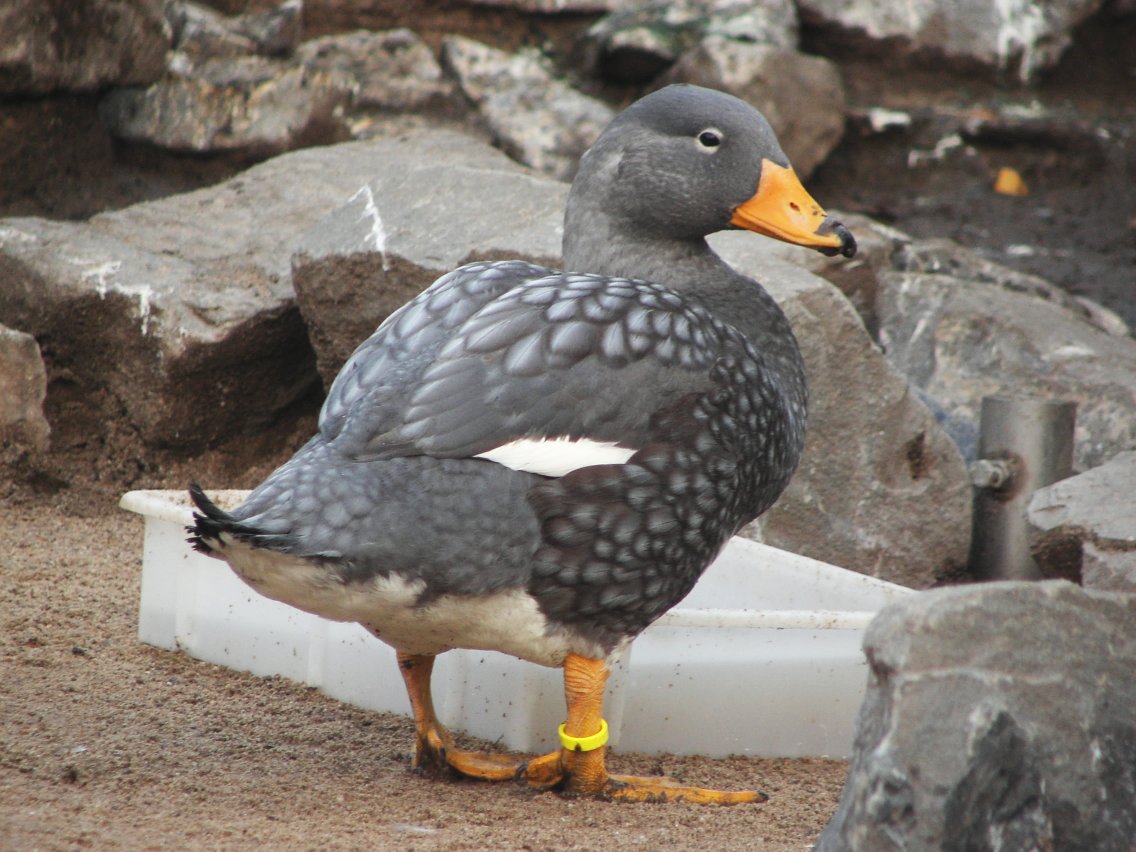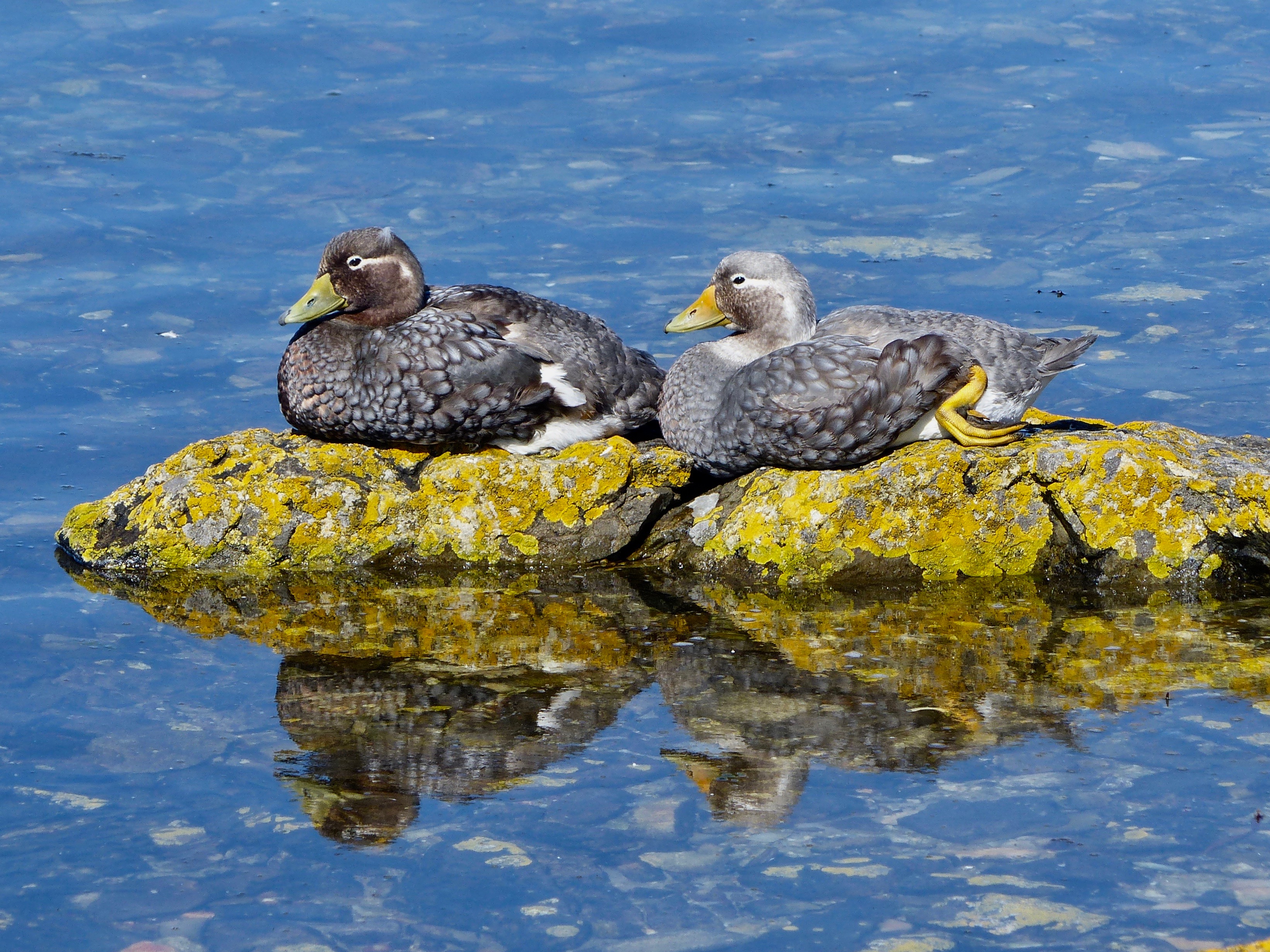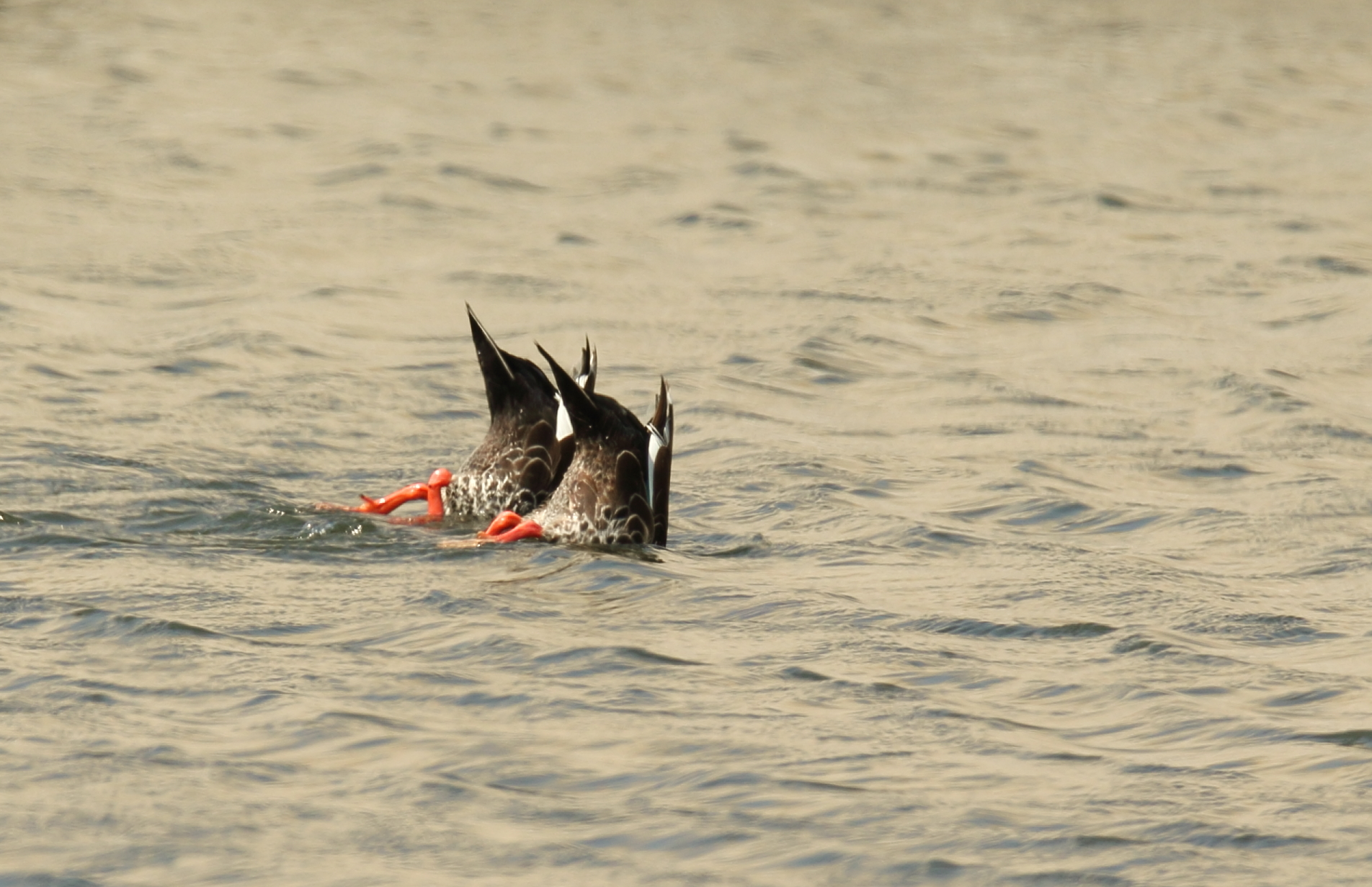|
Tachyeres
The steamer ducks are a genus (''Tachyeres'') of ducks in the family Anatidae. All of the four species occur at the southern cone of South America in Chile and Argentina, and all except the flying steamer duck are flightless; even this one species capable of flight rarely takes to the air. They can be aggressive and are capable of chasing off predators like petrels. Bloody battles of steamer ducks with each other over territory disputes are observed in nature. They even kill waterbirds that are several times their size. Taxonomy The genus ''Tachyeres'' was introduced in 1875 by the English zoologist Richard Owen to accommodate the Falkland steamer duck. The genus name ''Tachyeres'', "having fast oars" or "fast rower", comes from Ancient Greek ταχυ- "fast" + ἐρέσσω "I row (as with oars)". The common name "steamer ducks" arose because, when swimming fast, they flap their wings into the water as well as using their feet, creating an effect like a paddle steamer. They ... [...More Info...] [...Related Items...] OR: [Wikipedia] [Google] [Baidu] |
Tachyeres Pteneres
The Fuegian steamer duck (''Tachyeres pteneres'') or the Magellanic flightless steamer duck, is a flightless duck native to South America. It belongs to the steamer duck genus ''Tachyeres''. It inhabits the rocky coasts and coastal islands from southern Chile and Chiloé to Tierra del Fuego, switching to the adjacent sheltered bays and lakes further inland when breeding. Description This is the largest of the steamer duck species. It is a massively built waterfowl at and in length, with the males noticeably larger than the females. Males weigh an average of while females weigh around on average.''CRC Handbook of Avian Body Masses, 2nd Edition'' by John B. Dunning Jr. (Editor). CRC Press (2008), . The wingspan is , the wings being too small to functionally allow the birds to take flight. Instead, the wings are used like paddles to help skim rapidly across the surface of the water. This species outweighs any other wild species called "duck" and is about the same mass as the la ... [...More Info...] [...Related Items...] OR: [Wikipedia] [Google] [Baidu] |
Flying Steamer Duck (Tachyeres Patachonicus) (1)
The flying steamer duck (''Tachyeres patachonicus''), also known as the flying steamer-duck or flying steamerduck, is a species of South American duck in the family Anatidae. Taxonomy and Systematics The flying steamer duck is one of four steamer ducks, in the genus ''Tachyeres'', which also includes the Fuegian steamer duck (''Tachyeres pteneres''), the Chubut steamer duck (''Tachyeres leucocephalus''), and the Falkland steamer duck (''Tachyeres brachypterus''). The steamer ducks are named for their method of mobility, as the manner in which they use wings and feet to paddle across the water resembles an old-time steam boat. The steamer ducks are members of the Southern Hemisphere shelducks clade Tadorninae. The three flightless species are monophyletic, with the flying steamer ducks splitting off phylogenetically. It is the only steamer duck which can fly, and the only one to occur on inland fresh waters. However, some individual male flying steamer ducks within the specie ... [...More Info...] [...Related Items...] OR: [Wikipedia] [Google] [Baidu] |
Flying Steamer Duck
The flying steamer duck (''Tachyeres patachonicus''), also known as the flying steamer-duck or flying steamerduck, is a species of South American duck in the family Anatidae. Taxonomy and Systematics The flying steamer duck is one of four steamer ducks, in the genus ''Tachyeres'', which also includes the Fuegian steamer duck (''Tachyeres pteneres''), the Chubut steamer duck (''Tachyeres leucocephalus''), and the Falkland steamer duck (''Tachyeres brachypterus''). The steamer ducks are named for their method of mobility, as the manner in which they use wings and feet to paddle across the water resembles an old-time steam boat. The steamer ducks are members of the Southern Hemisphere shelducks clade Tadorninae. The three flightless species are monophyletic, with the flying steamer ducks splitting off phylogenetically. It is the only steamer duck which can fly, and the only one to occur on inland fresh waters. However, some individual male flying steamer ducks within the specie ... [...More Info...] [...Related Items...] OR: [Wikipedia] [Google] [Baidu] |
Tachyeres Patachonicus
The flying steamer duck (''Tachyeres patachonicus''), also known as the flying steamer-duck or flying steamerduck, is a species of South American duck in the family Anatidae. Taxonomy and Systematics The flying steamer duck is one of four steamer ducks, in the genus ''Tachyeres'', which also includes the Fuegian steamer duck (''Tachyeres pteneres''), the Chubut steamer duck (''Tachyeres leucocephalus''), and the Falkland steamer duck (''Tachyeres brachypterus''). The steamer ducks are named for their method of mobility, as the manner in which they use wings and feet to paddle across the water resembles an old-time steam boat. The steamer ducks are members of the Southern Hemisphere shelducks clade Tadorninae. The three flightless species are monophyletic, with the flying steamer ducks splitting off phylogenetically. It is the only steamer duck which can fly, and the only one to occur on inland fresh waters. However, some individual male flying steamer ducks within the specie ... [...More Info...] [...Related Items...] OR: [Wikipedia] [Google] [Baidu] |
Falkland Steamer Duck
The Falkland steamer duck (''Tachyeres brachypterus'') is a species of flightless duck found on the Falkland Islands in the South Atlantic Ocean. The steamer ducks get their name from their unconventional swimming behaviour in which they flap their wings and feet on the water in a motion reminiscent of an old paddle steamer. The Falkland steamer duck is one of only two bird species endemic to the Falkland Islands, the other being Cobb's wren. Taxonomy and systematics The Falkland steamer duck is part of the Anseriformes order and the Anatidae family alongside ducks, geese, and swans. It is in the genus ''Tachyeres'' with the three other species of steamer ducks, all found in South America. The Falkland steamer duck is most closely related to the flying steamer duck which can also be found in and around the Falkland Islands. It is believed that they might still be able to interbreed. A study from 2012 established that these two species are genetically indistinguishable. Howeve ... [...More Info...] [...Related Items...] OR: [Wikipedia] [Google] [Baidu] |
Tachyeres Brachypterus
The Falkland steamer duck (''Tachyeres brachypterus'') is a species of flightless duck found on the Falkland Islands in the South Atlantic Ocean. The steamer ducks get their name from their unconventional swimming behaviour in which they flap their wings and feet on the water in a motion reminiscent of an old paddle steamer. The Falkland steamer duck is one of only two bird species endemic to the Falkland Islands, the other being Cobb's wren. Taxonomy and systematics The Falkland steamer duck is part of the Anseriformes order and the Anatidae family alongside ducks, geese, and swans. It is in the genus ''Tachyeres'' with the three other species of steamer ducks, all found in South America. The Falkland steamer duck is most closely related to the flying steamer duck which can also be found in and around the Falkland Islands. It is believed that they might still be able to interbreed. A study from 2012 established that these two species are genetically indistinguishable. However, ... [...More Info...] [...Related Items...] OR: [Wikipedia] [Google] [Baidu] |
Tachyeres Leucocephalus
The Chubut steamer duck or white-headed flightless steamer duck (''Tachyeres leucocephalus'') is a flightless duck endemic to Argentina. It is the most recently recognized species of steamer duck, being described only in 1981. This is because it is only found along a rather small and sparsely populated stretch of coast around the Golfo San Jorge in southern Chubut and northern Santa Cruz Provinces, and because steamer ducks in general look fairly similar in plumage. Description Adult male Chubut steamer ducks have white heads with a bright yellow/orange bill with a black nail. Their webs and feet are yellow/orange with black claws. The rest of their plumage includes mostly grey bodies and white bellies. While the male is molting his bill turns to a duller yellow/orange. Adult female Chubut steamer ducks have brown heads and necks with small white line going from the back of the eye to the fore-neck. Their bills have a greenish/yellow color. The Adult female Chubut stea ... [...More Info...] [...Related Items...] OR: [Wikipedia] [Google] [Baidu] |
Flightless
Flightless birds are birds that through evolution lost the ability to fly. There are over 60 extant species, including the well known ratites ( ostriches, emu, cassowaries, rheas, and kiwi) and penguins. The smallest flightless bird is the Inaccessible Island rail (length 12.5 cm, weight 34.7 g). The largest (both heaviest and tallest) flightless bird, which is also the largest living bird, is the ostrich (2.7 m, 156 kg). Many domesticated birds, such as the domestic chicken and domestic duck, have lost the ability to fly for extended periods, although their ancestral species, the red junglefowl and mallard, respectively, are capable of extended flight. A few particularly bred birds, such as the Broad Breasted White turkey, have become totally flightless as a result of selective breeding; the birds were bred to grow massive breast meat that weighs too much for the bird's wings to support in flight. Flightlessness has evolved in many different birds indep ... [...More Info...] [...Related Items...] OR: [Wikipedia] [Google] [Baidu] |
Anatidae
The Anatidae are the biological family of water birds that includes ducks, geese, and swans. The family has a cosmopolitan distribution, occurring on all the world's continents except Antarctica. These birds are adapted for swimming, floating on the water surface, and in some cases diving in at least shallow water. The family contains around 174 species in 43 genera. (The magpie goose is no longer considered to be part of the Anatidae and is now placed in its own family, Anseranatidae.) They are generally herbivorous, and are monogamous breeders. A number of species undertake annual migrations. A few species have been domesticated for agriculture, and many others are hunted for food and recreation. Five species have become extinct since 1600, and many more are threatened with extinction. Description and ecology The ducks, geese, and swans are small- to large-sized birds with a broad and elongated general body plan. Diving species vary from this in being rounder. Extant s ... [...More Info...] [...Related Items...] OR: [Wikipedia] [Google] [Baidu] |
Dabbling Duck
The Anatinae are a subfamily of the family Anatidae (swans, geese and ducks). Its surviving members are the dabbling ducks, which feed mainly at the surface rather than by diving. The other members of the Anatinae are the extinct moa-nalo, a young but highly apomorphic lineage derived from the dabbling ducks. There has been much debate about the systematical status and which ducks belong to the Anatinae. Some taxonomic authorities only include the dabbling ducks and their close relatives, the extinct moa-nalos. Alternatively, the Anatinae are considered to include most "ducks", and the dabbling ducks form a tribe Anatini within these. The classification as presented here more appropriately reflects the remaining uncertainty about the interrelationships of the major lineages of Anatidae (waterfowl). Systematics The dabbling duck group, of worldwide distribution, was delimited in a 1986 study to include eight genera and some 50–60 living species. However, Salvadori's teal i ... [...More Info...] [...Related Items...] OR: [Wikipedia] [Google] [Baidu] |
Duck
Duck is the common name for numerous species of waterfowl in the family Anatidae. Ducks are generally smaller and shorter-necked than swans and geese, which are members of the same family. Divided among several subfamilies, they are a form taxon; they do not represent a monophyletic group (the group of all descendants of a single common ancestral species), since swans and geese are not considered ducks. Ducks are mostly aquatic birds, and may be found in both fresh water and sea water. Ducks are sometimes confused with several types of unrelated water birds with similar forms, such as loons or divers, grebes, gallinules and coots. Etymology The word ''duck'' comes from Old English 'diver', a derivative of the verb 'to duck, bend down low as if to get under something, or dive', because of the way many species in the dabbling duck group feed by upending; compare with Dutch and German 'to dive'. This word replaced Old English / 'duck', possibly to avoid conf ... [...More Info...] [...Related Items...] OR: [Wikipedia] [Google] [Baidu] |
Cytochrome B
Cytochrome b within both molecular and cell biology, is a protein found in the mitochondria of eukaryotic cells. It functions as part of the electron transport chain and is the main subunit of transmembrane cytochrome bc1 and b6f complexes. Function In the mitochondrion of eukaryotes and in aerobic prokaryotes, cytochrome b is a component of respiratory chain complex III () — also known as the bc1 complex or ubiquinol-cytochrome c reductase. In plant chloroplasts and cyanobacteria, there is an analogous protein, cytochrome b6, a component of the plastoquinone-plastocyanin reductase (), also known as the b6f complex. These complexes are involved in electron transport, the pumping of protons to create a proton-motive force ( PMF). This proton gradient is used for the generation of ATP. These complexes play a vital role in cells. Structure Cytochrome b/b6 is an integral membrane protein of approximately 400 amino acid residues that probably has 8 transmembrane segm ... [...More Info...] [...Related Items...] OR: [Wikipedia] [Google] [Baidu] |






